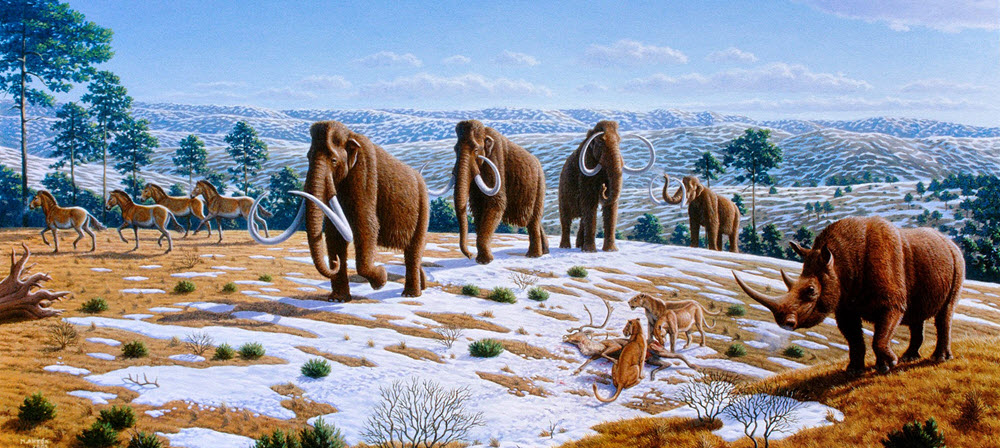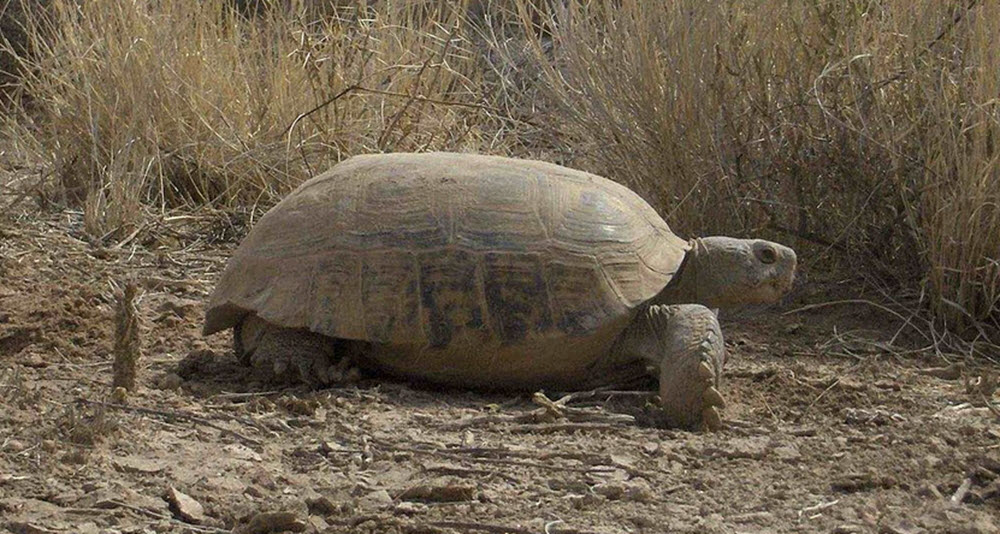Pleistocene rewilding
Contents
Pleistocene rewilding is the re-introduction of Pleistocene fauna (typically megafauna) to wilderness areas. In some contexts, the introduction of ecologically similar modern-day fauna is also referred to as Pleistocene rewilding.

A species that became extinct much later than the Pleistocene can still be included in a Pleistocene rewilding project, provided that it lived there during the Pleistocene. This can also be extended to proxies. Some of the projects included in Pleistocene rewilding can therefore involve the introduction of proxy animals – for a species that became extinct from the area much more recently than Pleistocene.
Example: The aurochs once roamed large parts of Europe, Asia and northern Africa, but went extinct in the 1600s CE. Today, rewilding projects in Europe that aim to mimic a Pleistocene grasslands typically use hardy breeds of domestic cattle to mimic the aurochs.
Because of this, the line between rewilding projects and Pleistocene rewilding tend to be fluent.
What is the Pleistocene?
Pleistocene is the most recent Ice Age, and it lasted from about 2,580,000 to 11,700 years ago. This is the Earth´s most recent period of repeated glaciations. The end of the Pleistocene roughly 11,700 years ago thus corresponds with the end of the last glacial period, and also with the end of the Palaeolithic age used in archaeology.
The term Pleistocene comes from Ancient Greek words ”pleistos” which means most and “kainós” which means new.
What is megafauna?
Animals with an adult body weight over 45 kilograms (99 lbs).
What is Pleistocene megafauna?
The term Pleistocene megafauna denotes the large animals that lived on Earth during the Pleistocene period but became extinct during the Quarternary extinction event.
The Quarternary period saw the extinction of many species, chiefly megafaunal ones.
The most prominent extinction event in the Late Pleistocene differed from the previous ones by the widespread absence of ecological succession. To put it simple: megafauna species died out roughly 13k-10k years ago and were not succeeded by other megafauna. This in turn caused major environmental changes, as previous ecological webs collapsed. This occurred in both Eurasia, Australia and the Americas.
Examples of done or suggested Pleistocene rewilding in North America
Ungulates and subungulates
- The pronghorns nearly went extinct in the United States in the modern age, but have made a comeback. They could now be reintroduced to parts of the great plains and other arid regions of the west and south-west where they once lived. Proghorns are considered crucial for the revival of the old ecosystems in these regions.
- The plains bison were almost extinct by European settlers in the late 1800s, but it now recovering in parts of the United States. In the Midwest, several rewilding projects are including the bison in their efforts.
- Rocky Mountain goats are being introduced to areas where the Oreamnos haringtoni used to live. Oreamnos haringtoni is a relative of the Rocky Mountain goat, but was extinct around 11,000 B.C. Harrington’s mountain goat was smaller than today’s mountain goats, and had a longer, narrower face and smaller horns.
- The collared peccary once lived in large parts of the United States, but is today limited to Arizona, New Mexico and Texas, from where it could be used in reintroduction programs. Relatives of this species are available from Central America and South America.
- Camelids once lived in drier regions of North America, but are today extinct there. Proxies could be reintroduced from South America, in the form of wild guanacos and vicuñas or domesticated llamas and alpacas. The guanaco is similar to Hemiauchenia, and Vicuña is similar to Palaeolama.
- Tapirs became extinct in North America during at the end of Pleistocene, but relatives are still present in Central and South America. The mountain tapir is an extant non-tropical tapir that could survive in parts of the United States.
- The North American proboscideans, such as the American mastodon and the Columbian mammoth, became extinct at the end of the Pleistocene. One of the closest relatives is the Asian elephant. This species is associated with the tropics today, but once also lived in temperate parts of the world, including northern China and parts of the Middle East. It is therefore considered a candidate for rewilding parts of North America, including non-tropical parts.
Carnivores
Examples of large carnivores that have gone extinct in North America are the short-faced bears, the sabre-toothed cats, the American lion, the American cheetah and the dire wolf. The introduction of similar species from other parts of the world have been suggested, e.g. introducing African lions as a proxy for the Pleistocene American lion to regulate the numbers of bison, camelids and equids in the wild.

Tortoises
- Bolson tortoises were widespread during the Pleistocene era and were still quite common in the United States until recently. Now, plans are in the works to reintroduce them from Mexico to parts of the United States to help with soil quality. A higher soil humidity caused by these tortoises would help support grasslands and extant shrublands and make them ready for the reintroduction of larger herbivores.
- In Hawaii, the large flightless duck moa-nalo was hunted to extinction soon after the first Polynesians had reached Hawaii. Today, non-native tortoises have been introduced to the Makauwahi Cave Reserve in Hawaii to fill the same niche as these ducks. Just like the moa-nalos, these tortoises will graze.
Examples of done and suggested Pleistocene rewilding in Africa
Malagasy radiated tortoise
Malagasy radiated tortoises have been introduced to the islands Mauritius and Réunion as a replacement for extinct tortoises that filled a similar niche on these islands.
Aldabra giant tortoise
The introduction of Aldabra giant tortoises to Madagascar has been suggested as a substitute for the extinct Malagasy giant tortoise. The Aldabra giant tortoise is today endemic to the islands of the Aldabra Atoll in the Seychelles, but were once present on Madagascar and many of the western Indian Ocean islands.
Examples of Pleistocene rewilding in Australia
Tasmanian devils
When Tasmanian devils were introduced to New South Wales in 2020, it was the first time devils lived on the Australian mainland for over 3,000 years. A total of 26 adult devils were released in a protected wildlife area in Barrington Tops. By late April 2021, seven joeys had been born.
Examples of Pleistocene rewilding in Asia
The Siberian Pleistocene rewilding area
The Siberian Pleistocene rewilding are is located in north-eastern Russia. Examples of animals that have already been introduced or reintroduced here are musk ox, Yakutian horses, Altai wapiti, Bactrian camel, wood bison, domestic yak, and wisent. Reindeer, Siberian roe deer and moose were already present when the land was selected for rewilding.